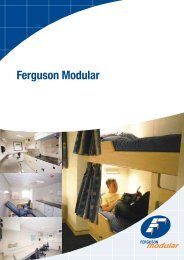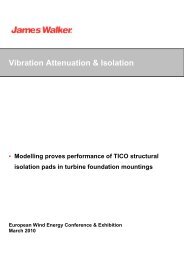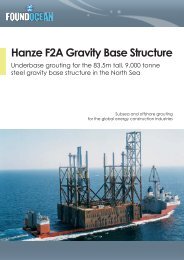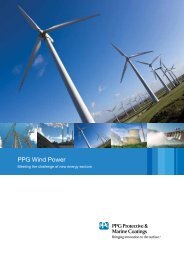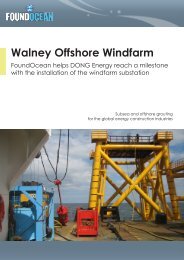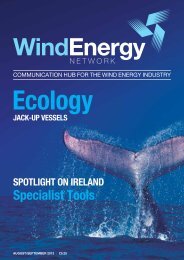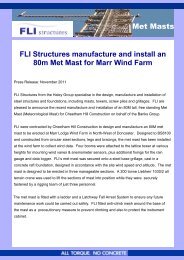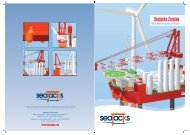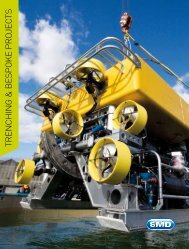SPONSORS OF TYNE & TEES FE<strong>AT</strong>UREVisualresidentialamenityseeingthrough theissuesThe Coalition Government’s LocalismAgenda is filtering down to localcommunities who feel empoweredto comment upon proposed localdevelopment. Some members of thepublic have strong views concerningwind energy development and objectto applications, seeking to influenceboth the relevant Case Officer and alsomembers of the planning committee.South SharpleyAn increasingly common issue is visualamenity associated with residentialproperties and local panning authoritiesare refusing projects on these grounds.One such example is at South Sharpleywhere Durham County Council issued arefusal notice concerning three turbines.The refusal notice alleged that theproposed development would have asignificant adverse visual impact on specificresidential properties. The applicant (REG<strong>Wind</strong>power) appealed against this decisionthrough written representation.No clear guidelinesCommercial wind farm development willinevitably cause some local visual effectsfor nearby residential properties. Despitemuch ill-informed rumour, there are no clearguidelines about the minimum distancefrom a property within which a wind turbinemay have an overbearing affect.A review of appeal decisions does assistin providing some useful benchmarkingconcerning the distance within which aturbine will be seen as being overbearing.The matter can be forensically analysedby undertaking a residential amenityassessment which specifically examinesparticular properties and their relationshipwith a development proposal. A number ofkey militating factors need to be consideredwhen assessing whether a turbine willhave an overbearing impact on any givenresidential property.No particular individual has a right to aview, but there comes a point by reasonof proximity and size of a turbine where aresidential property would be rendered sounattractive, as a place in which to live thatplanning permission should be justifiablyrefused. The key test is whether viewedobjectively, in the public interest, would aproperty become an unattractive place inwhich to live.Carland Cross and Burnt HouseFarm InquiriesThis test was applied at the Carland Crossand Burnt House Farm Inquiries. Clearly,there needs to be a degree of harm overand above an identified substantial adverseeffect on a private interest to take the caseinto the category of refusal in the publicinterest.Residential Visual Amenity Study(RVAS)A detailed RVAS was prepared for theSouth Sharpley appeal to examine to whatextent local properties would be affected.The appeal decision for South Sharpleywas issued in April 2011. In allowing theappeal, the Inspector was satisfied thatthe proposed development would notunacceptably harm the living conditions ofnearby residents. This demonstrates thatwhilst there can be substantial oppositionfrom local communities, careful examinationof the facts can clearly demonstrate thatthere would be no unacceptable harmupon residential visual amenity.Andy Cook/Paul BurrellPegasus Groupwww.pegasuspg.co.ukClick to view more info56www.windenergynetwork.co.uk
SPONSORS OF TYNE & TEES FE<strong>AT</strong>URESouth TynesideCollegeSouth Tyneside College’s MarineSafety Training Centre is one ofthe foremost training facilities inthe UK and has been developed toprovide the most realistic trainingenvironment possible.Within their training pool area there is aneight-seater helicopter escape module,helicopter winching arrangements, davitlaunchedlife raft equipment, a rangeof marine and aviation life rafts, survivalsuits, life jackets and associated survivalequipment, and an offshore platformtransfer simulator. The centre also has ajetty which provides mooring.A large, practical seamanship area isequipped with a wide range of shipboardequipment and models of ships’ structuresand devices. Other accommodationincludes modern classrooms and meetingrooms.urgent need for a review ofstandardsGraham Johnson is Head of School atSouth Tyneside College’s Marine SafetyTraining Centre in South Shields. He isa professional mariner to rank of Masterand has worked around the UK’s coastin tankers, supply boats and anchorhandlers. He also spent two years onsemi-submersible rigs in the North Seaand ran fishery patrol and survey vesselsfor the Environment Agency. He joined thecollege 13 years ago.Graham explains...To ensure the safety of employees, Ibelieve a review of the training standardis urgently needed within the marinesafety industry for transfer from vessel toinstallation.More realistic but controlled and safetraining is required than is currently laiddown by Renewable UK (RUK) and theEurope-wide Global <strong>Wind</strong> Organisation(GWO), the two safety accreditationbodies.Industry questionsTo start that process, two questionsshould be pondered by our industry andits regulators as they seek to give theiremployees the best possible training andfulfil their duty of care.1 Is transfer training in what can bedescribed as ‘benign’ conditions doinganyone any favours?2 How many days a year are the windand sea conditions around Europe’sshores so good that a transfer to orfrom an offshore turbine can be calledbenign?ExperiencesI have experienced a transfer in nearperfect conditions on Burbo Bank but,with the ever present risk of bow wavesfrom passing ferries and other vessels,nothing should be taken for granted.In the early days of RUK, a large numberwithin a sea survival working party arguedagainst transfer training in unrealisticconditions, those conditions which fail tomatch how it really is in the water.It was noticeable that those most in favourof this were those who were unable tocontrol the sea or water conditions andwho would have been at a disadvantageif the standard had dictated a set waveheight transfer requirement.Having delivered transfer training to amajor European company which specifiedtransfer in wave conditions, and havinggiven all our delegates the option ofbenign or wave conditions, all requestedmotion. I have no doubt that this is thebetter option.ObservationsVideo footage from inside transfer vesselsor from fixed cameras on installationsshow that transfers are taking placeroutinely in large wave conditions andthat individuals are transferring withoutadequate training. Comments fromdelegates on boat transfer courses reenforcethis point.Training providers across the country offerheight training. This intensive instructiontakes place at a realistic height and overtwo days offering training for a task that isin the main predictable and controlled.UnpredictableHowever, the transfer to or from a ladderto a vessel around the shores and furtherout to sea in European waters is far fromroutine and is unpredictable.Sadly, RUK and GWO require us only todo training that is carried out in the flatcalm and for only a very short period oftime, with no emergency scenarios orrescues practiced.No mandatory guidelinesFortunately, neither organisations’guidelines are mandatory and at therequest of individual companies wecarry out training as realistic as possibleto those witnessed around Europe’scoasts in our 4m-deep, 18m by 10menvironmental pool by using our variablewave pattern generator, as well as wind,rain, light and sound effects.Urgent needIt is because of RUK and GWO’sunrealistic guidelines that a review of thetraining standard is urgently needed. Thisis an industry that is growing rapidly, isin the public eye and can attract adversepublicity - and has no excuse from notlearning from industries that have workedwith the sea for decades.Graham JohnsonSouth Tyneside Collegewww.stc.ac.ukwww.windenergynetwork.co.uk 57



